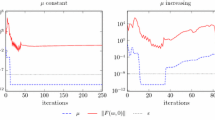Abstract
Numerical analysis of a class of nonlinear duality problems is presented. One side of the duality is to minimize a sum of Euclidean norms subject to linear equality constraints (the constrained MSN problem). The other side is to maximize a linear objective function subject to homogeneous linear equality constraints and quadratic inequalities. Large sparse problems of this form result from the discretization of infinite dimensional duality problems in plastic collapse analysis.
The solution method is based on the l 1 penalty function approach to the constrained MSN problem. This can be formulated as an unconstrained MSN problem for which the first author has recently published an efficient Newton barrier method, and for which new methods are still being developed.
Numerical results are presented for plastic collapse problems with up to 180000 variables, 90000 terms in the sum of norms and 90000 linear constraints. The obtained accuracy is of order 10-8 measured in feasibility and duality gap.
Similar content being viewed by others
References
K.D. Andersen, “An infeasible dual affine scaling method for linear programming,” Committee on Algorithms Bulletin (COAL), vol. 22, pp. 20-28, 1993.
K.D. Andersen, “An efficient Newton barrier method for minimizing a sum of Euclidean norms, SIAM J. Optim, vol. 6(1), pp. 74-95, 1996.
K.D. Andersen and E. Christiansen, “Limit analysis with the dual affine scaling algorithm,” J. Comput. Appl. Math., vol. 59, pp. 233-243, 1995.
K.D. Andersen, E. Christiansen, and M.L. Overton, “Computing limit loads by minimizing a sum of norms,” SIAM J. Sci. Comput., vol. 19(3), pp. 1046–1062, 1998.
A. Ben-Tal, M. Teboulle, and W.H. Yang, “A least-squares-based method for a class of nonsmooth minimization problems with applications in plasticity,” Appl. Math. Optim., vol. 24, pp. 273-288, 1991.
E. Christiansen, “Limit analysis of collapse states,” In P.G. Ciarlet and J.L. Lions, editors, Handbook of Numerical Analysis, vol. 4, pp. 193-312. North-Holland, Amsterdam, 1996.
A.R. Conn, “Constrained optimization using a nondifferentiable penalty function,” SIAM J. Numer. Anal., vol. 10, pp. 760-784, 1973.
B.A. Murtagh and M.A. Saunders, “A projected lagrangian algorithm and its implementation for sparse nonlinear constraints.” In A.G. Buckley and J.-L. Goffin, editors, Algorithms for Constrained Minimization of Smooth Nonlinear Functions, volume 16 of Mathematical Programming Study, pp. 84-117. North-Holland, Amsterdam, 1982.
M.L. Overton, “A quadratically convergent method for minimizing a sum of Euclidean norms,” Math. Programming, vol. 27, pp. 34-63, 1983.
T. Pietrzykowski, “An exact potential method for constrained maxima,” SIAM J. Numer. Anal., vol. 6, pp. 299-304, 1969.
R.T. Rockafellar, Convex Analysis, Princeton University, 1970.
Author information
Authors and Affiliations
Rights and permissions
About this article
Cite this article
Andersen, K.D., Christiansen, E. Minimizing a Sum of Norms Subject to Linear Equality Constraints. Computational Optimization and Applications 11, 65–79 (1998). https://doi.org/10.1023/A:1018322318259
Issue Date:
DOI: https://doi.org/10.1023/A:1018322318259




